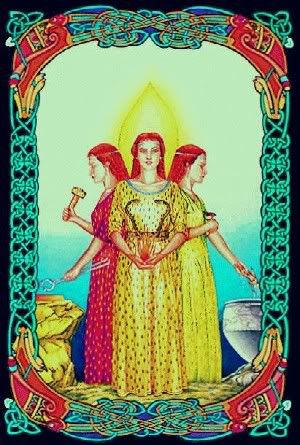

Also known as : Brid, Briggidda, Brigindo, Brigit, Brigit, Bride, Banfile
Brigit is an Irish Goddess identical with Dana and Brigindo. She is daughter of the god Dagda "The Good" and has two sisters also named Brigit. The three sisters were usually amalgamated into one entity. One is a goddess of poetry, handicrafts, and learning; one is a goddess of smiths and metalworking; and the third is a goddess of healing and fertility. Ecne is the grandson of Brigit. Ruadan, her son by Bres, was slain by Goibnui. For him she made the first keening that was ever heard in Ireland. She is honored on February 1st at Imbolc.
In her triple aspect, she was patroness of scholars, poets, healers, fertility, and smiths and metalwork. Her primary affiliations were with the element of fire, providing illumination, life and health, and creativity. The ancient Filid or bards were under her direct inspiration for the creation of filidhecht (poetry), and she was also important to the Druids as a goddess of divination. In Romano-Celtic temples she was frequently amalgamated with the goddess Minerva. It was she who first made the whistle for calling one to another through the night. Like the Norse goddess Hel, the one side of her face was ugly, but the other side was very comely. She was called Breosaighit, a fiery arrow, and her name can be traced all the way to the Sanskrit word Brhati which means "exalted one."
To the Christians she became Saint Brigit of Kildare, founding the first female religious community after Christianity had been established in Ireland. The nunnery of Kildare kept a perpetual fire which was not extinguished until the Reformation. Saint Brigit is the secondary patron saint of Ireland. Within Scottish tradition Brigid (the saint and the goddess) is associated with the lambing season and the coming of spring, when she ousts the winter reign of the Cailleach Bheur, the blue hag. The saint is also known as the 'Mary of the Gael,' credited with being the midwife to the Virgin. A folk-story tells how she played the fool by lighting a crown of candles and wearing it on her head to distract Herod's soldiers from the Holy Infant. Traces of Brigit can be seen in Brigantia.
Brigantia, meaning high one, is the titular goddess of the Brigantes of the West Riding in Yorkshire. She was worshiped almost exclusively by Cartimandue, queen of the Brigantes. Both the rivers Briant and Brent were named for her. A dedication and bas-relief at Birrens depicts her with the victorious attributes of Minerva and wearing the mural crown of Cybele which shows how the Romans adopted her into their own mythos. She is also called Caelestis Brigantia on an altar found in Corbridge Northumberland, and she is identified with Dea Callistis on a section of Hadrian's Wall. She was a goddess of water and herding, said to have been reared on the milk of a red eared cow (meaning it was not of this world). She is a Northern Celtic variation of the Irish Brigit. The Celts of Eastern France call her Brigindo.
Whenever the Romans occupied a new colony they were careful to propitiate the genius of the land. Britannia was the personified genia of Britain and was first depicted on a coin of Antoninus Pius (d. AD 161). Latterly, Britannia, with the attributes and weapons of Minerva, appeared on coins during the reign of Charles II in 1665, and became the symbol of the British Empire. She is the last remaining personification of Britain's native Sovereignty.